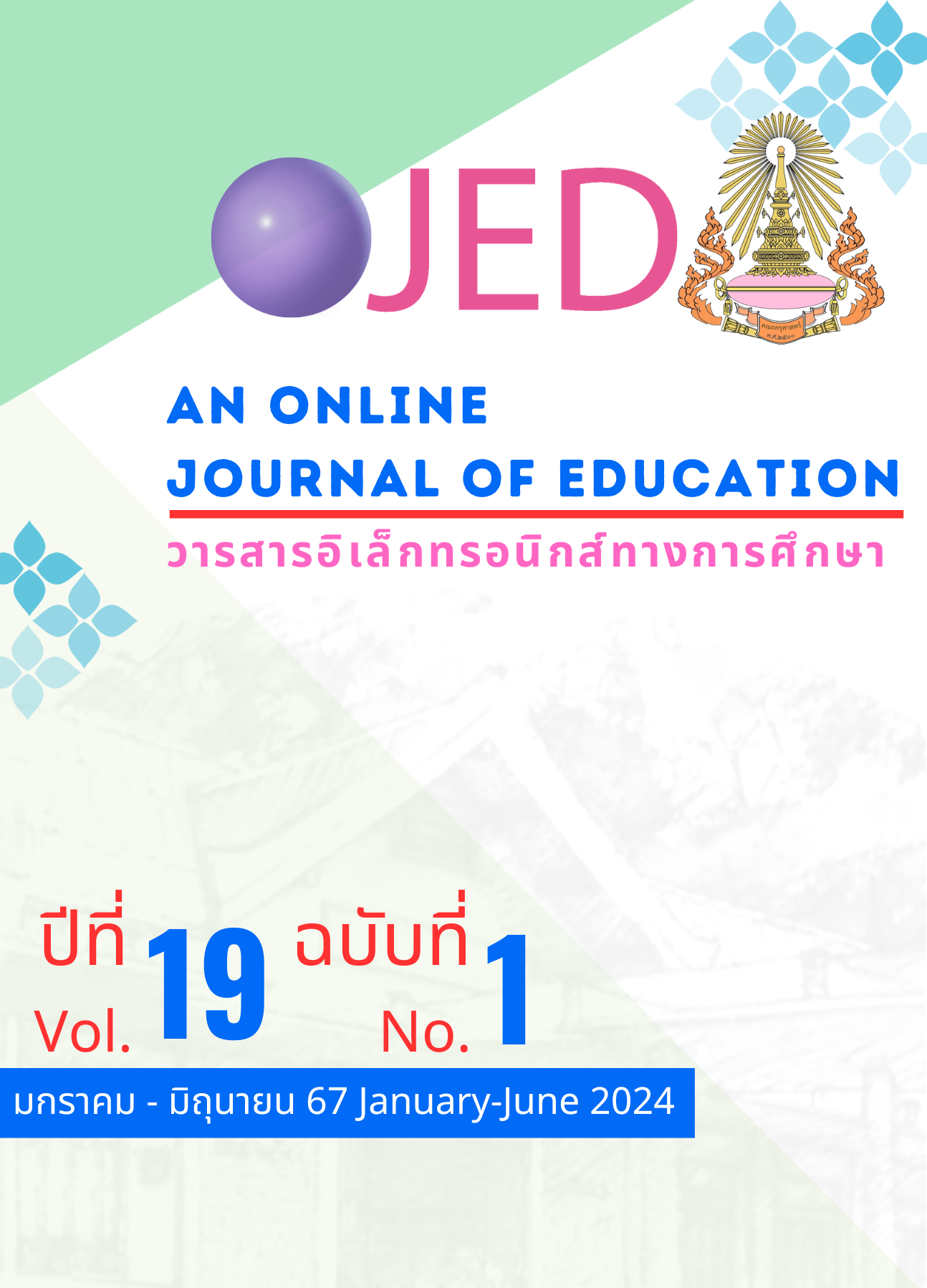Effects of Mathematics Learning Activities Using CORE Learning Model on Mathematical Conceptual Knowledge and Reasoning Abilities of Lower Secondary Students
DOI:
https://doi.org/10.14456/ojed.2024.17Keywords:
core learning model, mathematical conceptual knowledge, reasoning abilitiesAbstract
The purposes of this research were: 1) to compare the mathematical conceptual knowledge of the students following instruction using the CORE learning model at the 70% level; 2) to compare the mathematical reasoning abilities of the students before and after instruction using the CORE learning model; and 3) to compare the mathematical reasoning abilities of the students after instruction using the CORE learning model at the 60% level. The subjects consisted of 35 ninth grade students, and the instruments used for data collection included a mathematical conceptual knowledge test, and mathematical reasoning abilities tests. Data were analyzed using arithmetic mean, standard deviation, and t-test. The results of the research revealed that: 1) the mathematical conceptual knowledge of the students following instruction using the CORE learning model were higher than the minimum criteria of 70% at the .05 level of significance; 2) the mathematical reasoning abilities of students following instruction using CORE learning model were higher than those of the students before instruction at the .05 level of significance; and 3) the mathematical reasoning abilities of the students after instruction using the CORE learning model were higher than the minimum criteria of 60% at the .05 level of significance.
References
ภาษาไทย
กระทรวงศึกษาธิการ. (2560). ตัวชี้วัดและสาระการเรียนรู้แกนกลาง กลุ่มสาระการเรียนรู้คณิตศาสตร์ (ฉบับปรับปรุง พ.ศ. 2560) ตามหลักสูตรแกนกลางการศึกษาขั้นพื้นฐาน พุทธศักราช 2551. http://www.pwj.ac.th/main/flash-pdf/matat-2560.pdf
จิรวัฒน์ ตัณทานนท์. (2564). ผลการใช้รูปแบบการสอนที่เน้นกระบวนการแอบสแตรกชันร่วมกับกลวิธีการเรียนรู้เชิงภาพที่มีต่อความรู้ทางคณิตศาสตร์และความสามารถในการคิดวิเคราะห์ของนักเรียนชั้นมัธยมศึกษาปีที่ 4 [วิทยานิพนธ์ปริญญามหาบัณฑิต]. จุฬาลงกรณ์มหาวิทยาลัย.
ทรรศมน วินัยโกศล. (2561). ผลการจัดกิจกรรมการเรียนรู้คณิตศาสตร์ตามโมเดลของสไตน์ที่มีต่อความรู้และความสามารถในการให้เหตุผลทางคณิตศาสตร์ ของนักเรียนระดับชั้นมัธยมศึกษาปีที่ 3 [วิทยานิพนธ์ปริญญามหาบัณฑิต]. จุฬาลงกรณ์มหาวิทยาลัย.
พีชาณิกา เพชรสังข์. (2556). ผลของการจัดกิจกรรมการเรียนรู้คณิตศาสตร์โดยใช้รูปแบบการเรียนการสอน 5E ร่วมกับคำถามปลายเปิดที่มีต่อความสามารถในการให้เหตุผลทางคณิตศาสตร์และความสามารถในการคิดอย่างมีวิจารณญาณของนักเรียนมัธยมศึกษาปีที่ 2 [วิทยานิพนธ์ปริญญามหาบัณฑิต]. จุฬาลงกรณ์มหาวิทยาลัย.
สถาบันทดสอบการศึกษาแห่งชาติ. (2564). รายงานผลทดสอบทางการศึกษาระดับชาติพื้นฐาน (O-NET) ม. 3 ปีการศึกษา 2565. http://niets.or.th
สถาบันส่งเสริมการสอนวิทยาศาสตร์และเทคโนโลยี. (2555). ทักษะและกระบวนการทางคณิตศาสตร์. 3-คิว มีเดีย.
สถาบันส่งเสริมการสอนวิทยาศาสตร์และเทคโนโลยี. (2561). สรุปผลการวิจัย PISA 2015. https://drive.google.com/file/d/0BwqFSkq5b7zScUJOOV9ldUNfTlk/view
อัมพร ม้าคนอง. (2557). คณิตศาสตร์สำหรับครูมัธยม. ศูนย์ตำราและเอกสารทางวิชาการ คณะครุศาสตร์ จุฬาลงกรณ์มหาวิทยาลัย.
ภาษาอังกฤษ
Atiyah, K., & Priatna, N. (2023). The CORE learning model of junior high school students for improving the mathematical reasoning ability. Journal Nasional Pendidikan Matematika, 7(2), 280-289.
Fisher, D., & Yaniawati, P. (2017). The Use of Core Model in Enhancing The Mathematical Reasoning Ability of Junior High School. Proceeding ICMETA, 1(1), 22-32. https://jurnal.uns.ac.id/math/article/view/12014/10534
Khairini A., & Nanang P. (2023). The CORE Learning Model of Junior High School Students for Improving the Mathematical Reasoning Ability. Jurnal Nasional Pendidikan Matematika, 7(2), 280–280. https://doi.org/10.33603/jnpm.v7i2.7871
Miller, R. G., & Calfee, R. C. (2004). Making thinking visible: A method to encourage science writing in upper elementary grades. Science and Children, 42(3), 20-25.
Nurasiah, A. A., & Sharfina N.A. (2021). The Effect of Connecting, Organizing, Reflecting, and Extending (CORE) Learning Model on Students’ Learning Motivation. Proceedings of AICS - Social Sciences, 11(0), 144–156.
https://jurnal.usk.ac.id/AICS-Social/article/view/24343
O'Daffer, P. G., & Thornquis, B. A. (1993). Critical thinking, mathematical reasoning, and proof. In S. Patricia (Ed.), Research Ideas for the Classroom High School Mathematics (pp. 39-50). Macmillan.
Putri Ari, A. A. I. P., & Abadi, I. B. G. S. (2020). Improving science learning outcomes through CORE learning model based on SETS. Journal of Ilmiah Sekolah Dasar, 4(4), 655-666.
Saregar, A., Nur, U., Misbah, C., Susilowati, N. E., Anugrah, A., & Muhammad, N. (2021). CORE learning model: Its effectiveness towards students’ creative thinking. International Journal of Evaluation and Research in Education (IJERE), 10(1), 35. https://doi.org/10.11591/ijere.v10i1.20813
Sari, E. P., & Karyati. (2020). CORE (Connecting, Organizing, Reflecting and Extending) learning model to improve the ability of mathematical connections. Journal of Physics: Conference Series, 1581, 012028. https://doi.org/10.1088/1742-6596/1581/1/012028
Downloads
Published
How to Cite
Issue
Section
License
Copyright (c) 2024 An Online Journal of Education

This work is licensed under a Creative Commons Attribution-NonCommercial-NoDerivatives 4.0 International License.




